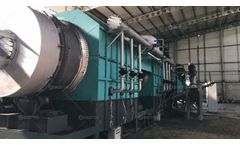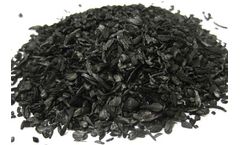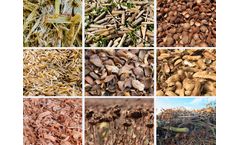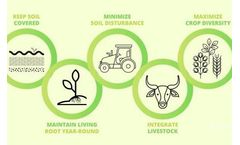Climate Change Mitigation Articles & Analysis
28 articles found
These microbes contribute to nutrient cycling and overall soil health, adding a long-term benefit to soil ecosystems when biochar is incorporated into the land. Carbon Sequestration and Climate Change Mitigation Biochar production from agricultural waste is a proactive step in carbon sequestration, an important factor in climate ...
As global agricultural practices address environmental and economic challenges, regenerative agriculture has stood out as a promising approach to creating more sustainable and robust farming systems. This farming method focuses on restoring soil health, enhancing biodiversity, and improving water cycles, ultimately leading to more sustainable food production. Innovative tools and technologies are ...
This creates a happy home for beneficial soil microbes that break down organic matter and contribute to overall soil health.Climate Change Warrior: Biochar stores carbon captured from the atmosphere during biomass conversion. This helps mitigate climate change by sequestering carbon in the soil. Biochar and Sustainable ...
Introduction Soil quality is a pivotal factor in sustainable agriculture and combating climate change. The new European Union (EU) Soil Monitoring Law aims to address this by ensuring healthy soils across all member states by 2050. ...
Carbon Sequestration: Biochar sequesters carbon in the soil, mitigating greenhouse gas emissions and contributing to climate change mitigation efforts. ...
Environmental Impact and Sustainability 1. Mitigating Greenhouse Gas Emissions The conversion of waste biomass into charcoal plays a crucial role in mitigating greenhouse gas emissions. By sequestering carbon in biochar and displacing the need for fossil fuels, this process aligns with sustainability goals, contributing to climate ...
As part of this carbon credit ecosystem, biochar producers and users are recognized as ecological stewards, actively mitigating climate change. Their commitment to soil enrichment and carbon sequestration not only improves the quality of agricultural produce but also provides a revenue stream through carbon credit trading. ...
Advantages of Choosing Biochar Production Carbon Sequestration and Climate Change Mitigation Biochar production is a significant contributor to carbon sequestration. The stable carbon structure of biochar allows it to lock carbon for an extended period, mitigating climate change impacts. Nutrient ...
As algae-based research rises in prominence for its potential in renewable energy production and climate change mitigation, the need for high-precision analytical equipment is paramount. ...
Agriculture in the UK is responsible for 9% of total greenhouse gas emissions, with that number rising to 30% of worldwide total emissions.1 There are a variety of sources for such gases in agriculture, including methane production from livestock, carbon dioxide release on soil disturbance, and emissions from farm machinery.2-4The question is how to reduce such emissions. Under the 2008 ...
The term “regenerative agriculture” is gaining prominence in climate-related conversations. It dates back to the 1980s when Robert Rodale coined the term, “regenerative organic agriculture” as way to express that organic should be more than simply avoiding chemical inputs. The term has been defined and re-defined by many different authors, sometimes describing very ...
If you are looking for a classic example of the circle of life, consider the forest canopy structure. A forest’s canopy structure is influenced by environmental and soil factors, and it also influences these factors in return. It is an aspect of forest ecology that is receiving more attention in this age of climate change emergency. The canopy structure is often overlooked, with most of the ...
Analysis of the root system is important in ensuring sustainable crop production, reducing nutrient input and irrigation, and protecting soil carbon pools. Getting rapid and frequent images of what is happening underground can help people make timely decisions about agricultural practices to maintain plant health and ensure the judicious use of resources. Root analysis can reduce financial and ...
The Importance of Root Analysis Root analysis is important not only to improve and increase food production but also for environment protection and fighting climate change. Roots are responsible for the discovery and efficient use of water and nutrients. ...
The understanding of controls helps improve the models and methods used for the annual reporting of greenhouse gas changes to UNFCCC (United Nations Framework Convention on Climate Change) as well as local soil managements. ...
The economic impact of climate change on European agriculture A new study has estimated how changes to climate might affect the value of European farmland. ...
Honestly at that time, we didn’t really know what changes we were going to make, we just knew that what we were doing wasn’t ...
ByEnsia
Specifically, FAO states that UPH is contributing to human health, food security, sustainable livelihoods, improved incomes and therefore lower poverty levels and cleaner environments. UPH can also contribute to climate change mitigation by reducing urban heat, carbon sequestration and by absorbing harmful gases from the urban environment (AIPH, ...
But the Guna are now facing formidable challenges to their survival, many of which are also affecting other indigenous communities across the world: the impacts of climate change, encroaching outside influences and a younger generation that’s drifting away from its roots. ...
ByEnsia
Other documented benefits of biotech crops go beyond agricultural improvement to climate change mitigation and environmental sustainability. GM technology has demonstrated the power to provide a better environment and breed crops resilient to harsh climatic conditions such as drought. ...















